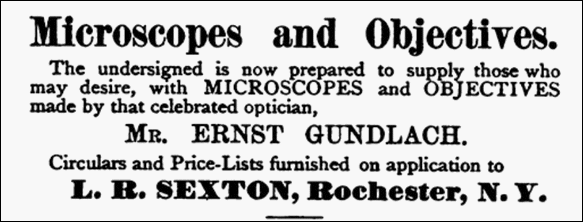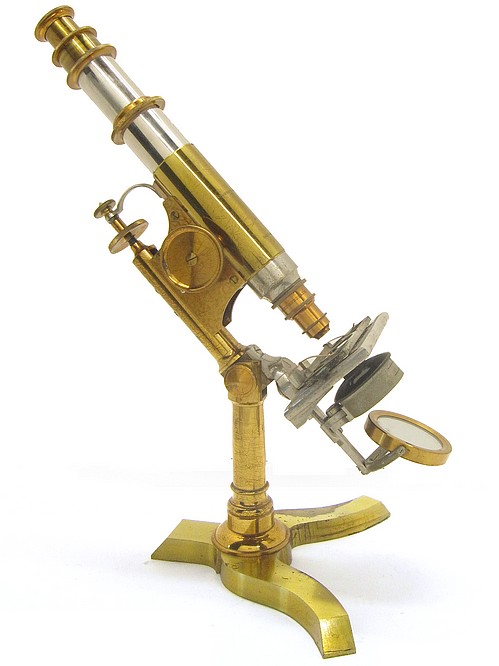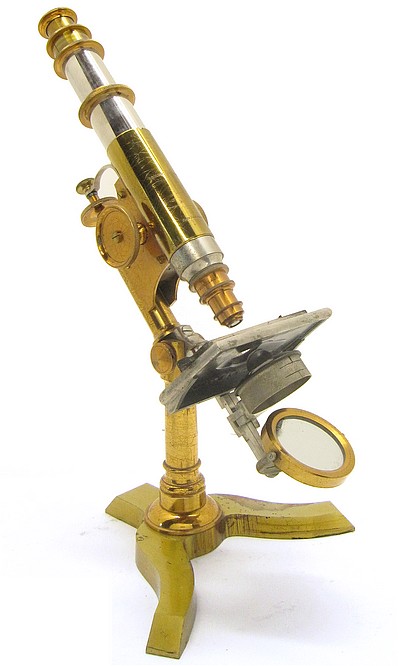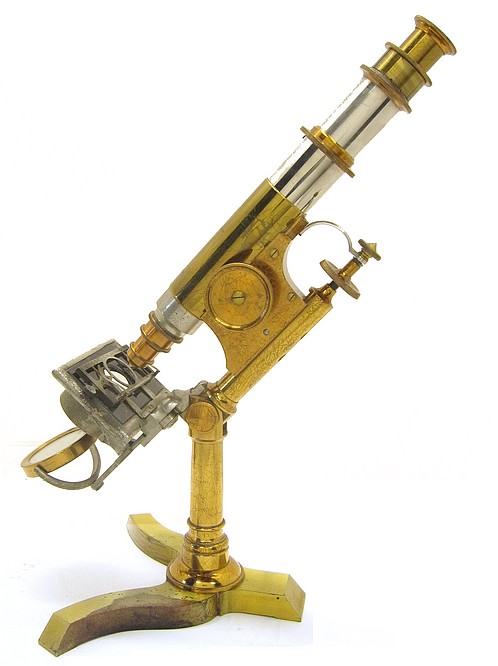
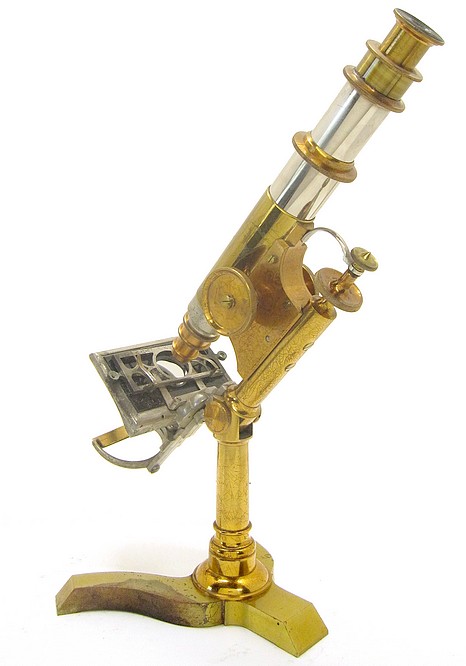
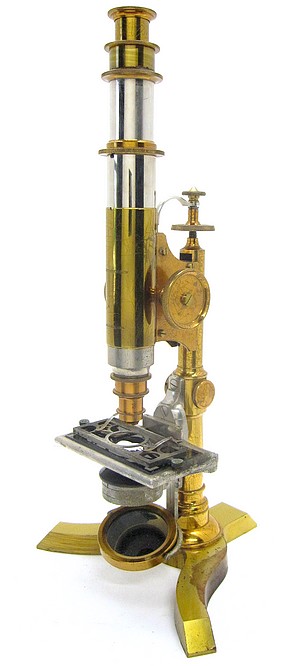
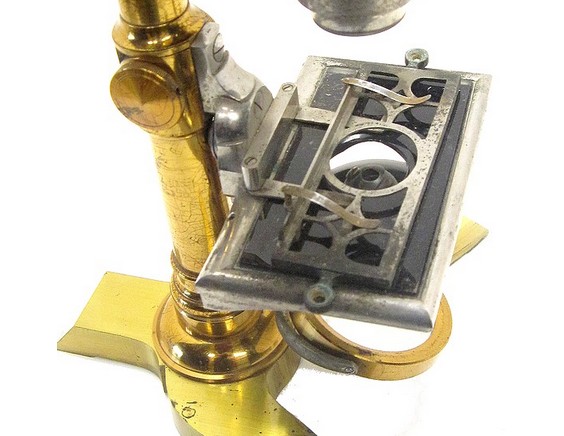
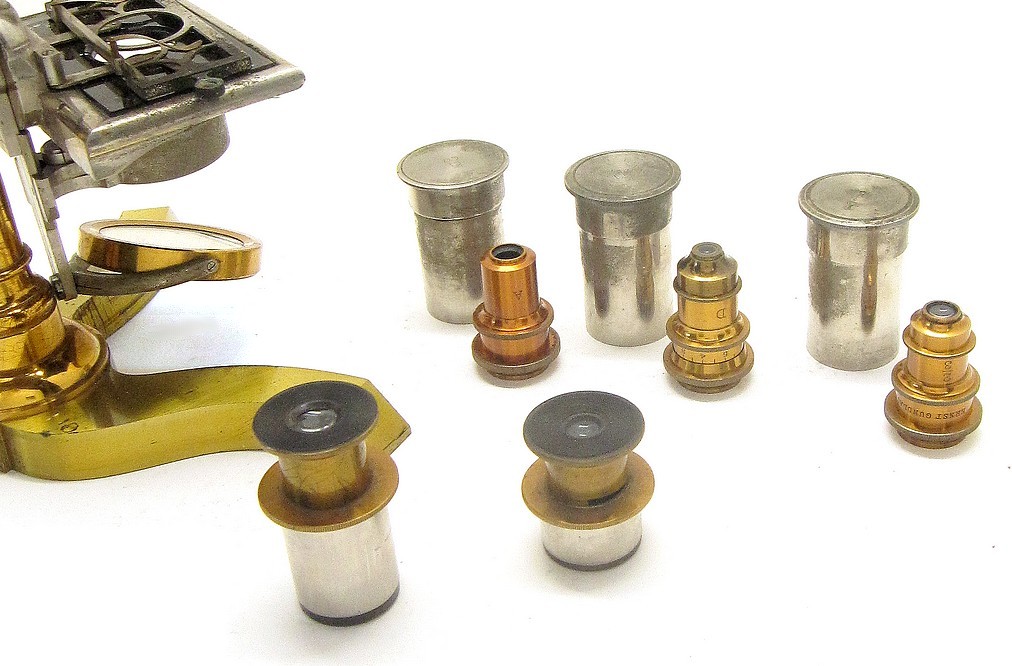
With the draw-tube partially extended, the microscope measures about 14-inches in height as shown in the photos.
The stage is glass, held in a nickel-plated brass frame, on which is Gundlach's patented mechanical slide carrier.
Among the accessories are three Gundlach objectives with canisters, a 2-inch, a 1/5, and a
divisible lens marked 2/3 and 1 1/2, two eyepieces, and a substage aperture fitting. The case
with lock and key has two internal drawers. Within the case is an instruction card by L. R. Sexton
located at 29 Stone St. Rochester NY. Lewis R. Sexton was the sales agent for Gundlach microscopes
during the years 1879-1884.
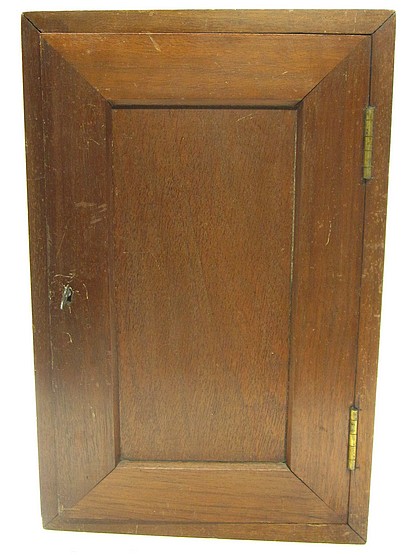
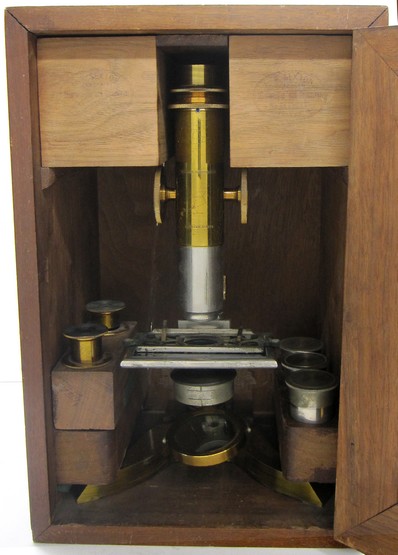
The following was extracted from The Journal of the Royal Microscopical Society, 1882, pg. 670
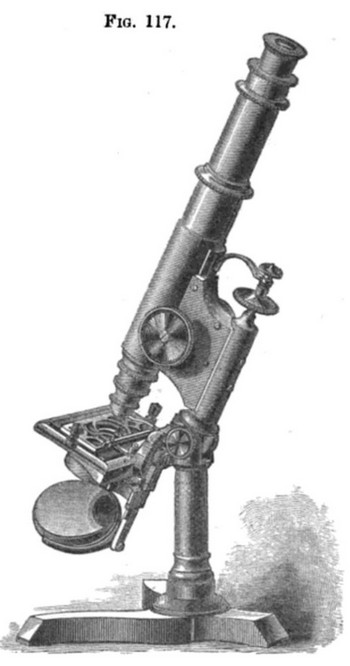
Gundlach’s College Microscope—This Microscope, till now called the “Physician’s Microscope No. 1” is shown in Fig. 117. Its speciality consists in the adjustments, of which there are four, thus described (from the maker’s catalogue) :
“( 1 ) A rack-and-pinion movement; (2) a sliding adjustment of the body; (3) a micrometer-screw, and (4) a combination of micrometer-screws giving a slower motion than has ever been brought into use before. The racks and pinions are cut with some new and original tools and with the greatest exactness."
Gundlach was the first to think of the advantages of the combination of the sliding adjustment with the rack and pinion, and to bring out a series of Microscopes on this plan. The former allows the body to be removed for changing objectives; and, by combining the two, the body may be made to stand so high that first-class low-power objectives may be used on these stands. Lower powers may be used on them than most large stands will allow.
The ordinary fine adjustment is by micrometer-screw acting on Gundlach’s new frictionless roller motion, patented in 1879. This motion is free from the fault of displacement of the optical axis, from so-called loss of motion, and from lateral motion, while it has twice the old extent of motion.
In working high powers, microscopists have felt the need in some work of a slower motion than that of the ordinary micrometer-screw, which cannot be made much finer and still be durable enough. This need is now supplied by the combination of two screws which give a resultant motion equal to the difference in the threads employed. One of these screws is a little coarser than the ordinary micrometer-screw, and may be used alone as a fine adjustment, and a change can be made instantly from this to the finer motion. Either motion is given by one milled head next to the top of the pillar, and the change is made by turning a smaller clamping screw having its head over the fine adjustment screw. By tightening the clamping screw, the adjustment is in order for the work of the combination; by loosening, for that of the coarser screw only. As the thread of this is a very little coarser than the ordinary micrometer- screw, it alone gives a better motion for medium powers than the fine adjustment in common use, a second advantage of the invention. the combination of screws in use on these Microscopes gives a motion equivalent to that of a screw having three hundred and sixty threads to the inch. Any desired combination can be made.
The stage consists of a strong, polished glass plate, made secure by a brass frame, which is nickel-plated. The glass plate has a hole in the centre, and is ground to permit the greatest obliquity of light. A new object carrier, consisting of an ornamented brass frame, with a rest for the object slide, removable clips, and two handles, moves with evenness upon the stage, to which it is pressed by lever springs, with double joint, to permit motion in every direction, and from which it is kept by frictionless pins that do not scratch the stage. The whole carrier can be removed and its place supplied with spring clips.
The substage slides along the mirror-bar, thus keeping the diaphragm or other accessory concentrically with the mirror upon the object with central as well as oblique illumination. It can be removed without interfering with the mirror.
The diaphragm is of novel construction, and is fitted to the substage. It is of such form that it can be brought close to the slide, and its openings brought in use without changing its position on the mirror-bar.
The mirror-bar swings to an anglo of 45° above the plane of the object, allowing the mirror to be used as a condenser on opaque objects. The mirrors have their centre of motion around the point where the optical axis intersects the plane of the object.
The Jan. 21, 1879 patent covers Gundlach's frictionless fine adjustment, the substage, and the stage slide carrier.
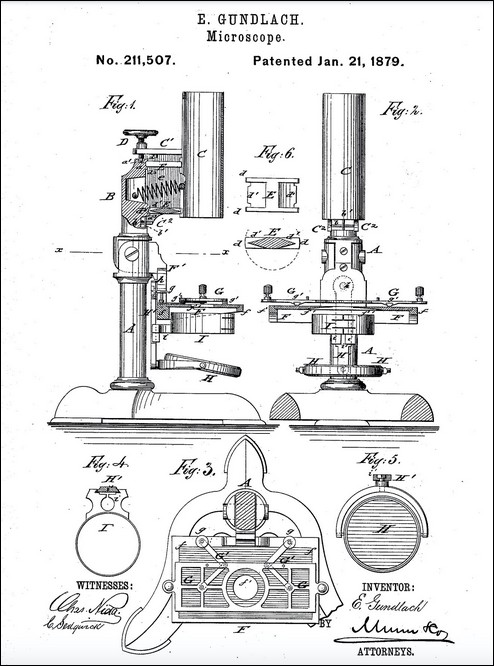
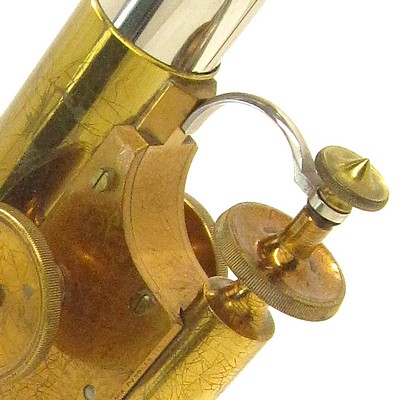
As mentioned elsewhere on this site, there was a collaboration on the production of microscopes between Ernst Gundlach and the firm Yawman & Erbe. With the College Microscope, Gundlach incorporated a differential screw mechanism onto the fine adjustment, which was patented by Philip Yawman on Aug. 15, 1882. The following description of the operation of this differential screw was extracted from the Odontographic Journal, 1881, pg. 94:
The same gentleman also exhibited a new fine adjustment for microscope stands, invented and manufactured by Messrs. Yawman & Erbe, of this city. What are commonly called fine adjustments rarely get beyond one hundred threads to the inch, but this a differential screw, which is a compound screw by which a motion is produced equal to the difference of the motions of the component screws gives a movement equal to three hundred and sixty threads to the inch. This exceedingly fine movement may be reduced, by loosening a conveniently placed milled-head screw, to sixty threads to the inch, an adjustment sufficiently fine for all low power objectives.
A similar microscope signed by Yawman & Erbe also incorporates this type of differential screw mechanism, albeit with a different fine adjustment construction.
The following description of Gundlach's contributions to microscopical optics was extracted from the Proceedings of the American Society of Microscopists (1882):
ERNST GUNDLACH Was born in Pyritz, Prussia, 1834; was educated there and in Berlin, where he took a course in one of the leading workshops (C.Lewert) to learn the trade of philosophical instrument-maker; afterwards working with other firms, and always choosing those who were doing their own optical work, in the hope of adding practical knowledge to the theoretical principles of optical science with which he was already familiar. On account, however, of the habit of opticians of keeping their methods of work strictly secret, young Gundlach learned little or nothing of practical value in this special line and, in 1866, he started optical work for himself, knowing nothing of the methods of others, except that emery is used for grinding, and rouge for polishing lenses. Technical difficulties soon presented themselves, only to be overcome by the enthusiasm of the young optician, and in about six months he had completed his first microscope, with three objectives and two eye-pieces. This instrument was purchased by Prof. Berg, of the University of Berlin, who, though a stranger to Mr. Gundlach, recognized the fine quality of his work. The next year he exhibited at the Paris Exposition his glycerine immersion objectives, and received therefor a special medal. This Mr. Gundlach believes to be the first instance of the intentional construction of objectives for use with an immersion fluid of higher refractive index than water. A frictionless fine adjustment for microscope stands was another of his inventions about this time.
In 1873 Mr. Gundlach, who had already become recognized as one of the greatest of living opticians, removed to this country and located at Hackensack, N. J. His first work here was the construction of two water immersion objectives (a 1/6 and 1/16 for Prof. Thacker, of Cincinnati, O., which won the admiration of many very competent judges, including Dr. Woodward, of the U. S. A. Medical Museum, Washington, D. C. In 1875, Mr. Gundlach invented his so- called “glycerine adjustment,” in which, by means of a layer of heavy glycerine of variable thickness confined between the front of the anterior lens of the objective and a plane glass cover, compensation is made for varying thickness of cover glass without alteration of optical adjustment or change of magnifying power.
In 1876 Mr. Gundlach brought out his hemispherical condenser and his periscopic eye-piece, the latter being an improvement on the orthoscopic ocular of Kellner.
In 1879 he discovered a new optical principle, upon which the construction of his globe lens is based. The construction of this lens is very peculiar, consisting of a solid and perfect globe of crown glass enclosed in cement within a hollow globe of flint glass, the corrections being obtained by the thickness of the flint.
In 1880 Mr. Gundlach produced a series of homogeneous immersion objectives, having apertures of 136° in balsam (1.41 N. A.), and combining remarkable working distance with most excellent corrections and performance.
Mr. Gundlach has also made some notable contributions to the literature of microscopical optics, among which may be mentioned his discussion of numerical working distance of objectives, and a new method of measuring apertures from 87° to 1800 in crown glass (1.14 to 1.52 N. A.) It will be seen that, so far as practical optics is concerned,'Mr. Gundlach is an autodidact, as, from the secrecy maintained by European opticians in regard to their methods of work, he was unable to learn but little, if anything, and was forced to work out his methods for himself.
